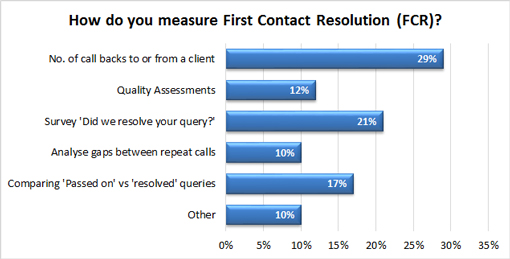There are a number of ways to measure First Contact Resolution (FCR). We asked our panel what they thought worked best.
The easiest way is to ask the customer
The easiest way to establish if FCR is being achieved is to ask the customer.
Surveys asking the simple question “did we resolve you query the first time you contacted us?” or “did you need to contact us more than once to resolve your query?” give you a real insight in to how you are performing.
The only issues are that sometimes customers will need to contact you more than once for many and varied reasons, and a lot of customers won’t complete a survey!
Combine surveys with the monitoring of an interaction ID that is specific to the query for that customer on that one occasion. You’ll then be able to see if customers contacted you more than once about the exact same topic/ issue/ query.
With thanks to Richard
Track everyone from the point they pick up the phone
We have found that when FCR is only measured when the caller has got through to an agent, a range of customer contact is missed that legitimately should be captured in any true measure of FCR.
For example, if someone calls you and you are closed, or if they can’t get through (all lines busy) or drop out in an interminable IVR message, they have to call back.
They also may get through to an agent but don’t provide sufficient account details to allow them to be tracked as a repeat caller.
By not measuring these “invisible” contacts, around a quarter of all call attempts that represent undue customer effort, and not FCR, get lost.
We have also found that surveys can be badly skewed by the type of caller who takes the time to complete them. They’ve either got a grievance or too much time on their hands – whichever it is, such surveys generally miss the people you are most interested in.
Our solution to this was to capture 100% of customer contacts by tracking everyone from the point they pick up the phone, as this creates a more insightful picture.
With thanks to Nick
Act on the causes you already know about

Michael Allen
Make no mistake about it, FCR is really about repeat contact, and most organisations have between 8 and 12 distinct repeat contact reasons that they know about already!
You should aim to get rid of the big bottlenecks first – a Customer Service Director who clears five bottlenecks in two years will have done a superb job.
With thanks to Michael Allen, Practice Leader at Right First Time Contact Centre
Give your agents a tick sheet to fill out over a 3-day period

Mats Rennstam
One manual way to monitor FCR is to give a number of advisors a tick sheet on which they note down if queries were solved or not over three days.
When later checking this against customers’ views, you’ll likely find that advisors aren’t just honest, but tougher on themselves than the customers.
With thanks to Mats Rennstam at Bright UK Ltd
Be clear on your definitions – and inclusive and exclusive criteria
When measuring FCR, it’s vital that you are clear on your definitions and inclusive and exclusive criteria.
For example, are you defining ‘resolved’ as being when the issue has been dealt with AND if the customer was satisfied?
On the whole, the most important tool in your FCR kit should be the call centre software that allows you to track FCR in an appropriate way for your business.

Ken Reid
This will allow advisors to ask customers at the end of a call or email whether or not their issue was resolved to their satisfaction, and to make a record in the system.
Additionally, automated after-call surveys can capture the customer’s view of whether an issue has been resolved or not.
With thanks to Ken Reid at Rostrvm Solutions
Speech analytics can provide a reliable method to measure FCR
Speech analytics is one technology that can provide a highly reliable method to measure your repeat call rate.
It also allows companies and organisations to understand why the customer’s need was not resolved in the first call.
This helps the company to identify where they are going wrong and can help reduce the number of repeat calls they get in the future.
As well as analysing the phone calls, speech analytics also allows the company to measure the number and type of repeat calls generated by each specific agent, which provides a targeted method for agent development and SLA improvement.
Set up an automated follow-up email to go to each of your customers
While this can be a daunting task if your company deals with a lot of phone calls every day, an automated follow-up email could be enough to get you the information.

Stefan Captijn
After the phone call, you could send an email or text message asking if the customer’s problem was solved.
It will get you the information you need as well as making the customer experience better.
With thanks to Stefan Captijn, Senior Director Product Marketing at Genesys
Quality monitoring can identify how calls are being resolved
When measuring FCR, we are tracking customer satisfaction. Therefore the contact is only truly resolved when the customer is fully satisfied, so in order to know if that’s the case you may need to use a number of different tracking methods.
A call recording system can be useful here, as it can enable quality monitoring to rate when and how calls are being resolved.
However, it is important to bear in mind that only the customer truly knows when their issue has been resolved.
Therefore, adding post-call customer surveys to your processes can provide valuable additional insight into how satisfied they really are.
Monitor social media channels to see what your customers are saying
Monitoring what your customers are saying online and asking how they feel they’ve been dealt with is a good way to measure FCR, as people are more likely to be honest online.
Actions speak louder than words
It is important to remember when measuring FCR that a customer’s actions may speak louder than their words.
Keep an eye on whether they making contact after their issue has supposedly been resolved – repeat call tracking technology can allow you to monitor this. CRM integration can also help you to track where they are making repeat contact via other channels.
Keep track of different touch points

David Ford
It is worth keeping in mind that a customer who called first time round may not want to call again if they weren’t satisfied, and may instead use email, social media or chat.
By adopting a multiple touch-point approach to measuring first contact resolution, it is possible to get a true picture of how satisfied your contact centre is leaving customers.
With thanks to David Ford, Managing Director at Magnetic North
Log why customers are calling
The industry frequently talks about root cause analysis and call avoidance.
But the reality is that when we are out reviewing contact centres, we find many do not measure the reason for the customers’ calls – at least not in an ongoing and analytical way.
It is important to log why your customers are calling, as it’s not just about quality. There are significant cost savings to be made as well, especially when you begin looking at factors like reducing call-backs.
Automate customer feedback
By using customer feedback to understand why a customer didn’t feel their issue was solved, the contact centre is able to enlighten other departments on what customers think about their deliveries, websites, pricing or products.
If this is also fed back to the advisor who handled the contact it will create a self-learning and self-correcting machine.
By filtering out the customers scoring low on FCR and having their verbatim converted into text, managers can also create Top 10 lists showing staff and directors the main reasons for unresolved customer queries month by month.
Address the three most common reasons for low FCR
Another way to measure and monitor FCR is to address the three most common reasons for experiencing low levels of FCR.
- Mandate – the advisor wants to help the customer but isn’t allowed to.
- Competency – the advisor does not have the right training to be able to help.
- Systems – the technology support (e.g. knowledge database) is not good enough.
Fix this and you’ll be on your way to seriously impressive FCR scores and outstanding customer satisfaction scores.
With thanks to Mats Rennstam at Bright UK Ltd

A poll of 173 Call Centre Helper readers in April 2014.
Separate systemic and non-systemic reasons
The reality is the most serious repeat reasons by volume are always systemic and not agent-caused.
You will be most successful if you measure FCR repeat reasons, then separate the reason codes to fully understand if the cause is systemic or non-systemic.
Raise the pressure on your systems people
Systemic resolution deadlines are not widespread, but agent ones are.
It’s not just the agent’s responsibility for FCR – every employee is responsible, whether they are directly engaging the customer or supporting people who do.
Raise the pressure on systems people.
Go across department on systemic failure
Don’t be lax on systemic failures! Too many organisations fail to address this systemic challenge for political, inertia and red-tape reasons.
We also see the Lean/Six Sigma people being departmentalised in that they can only work on the repeat when it is in their own department – a frankly ridiculous situation, but probably true of half the organisations we come across.
Try to remove one major systemic repeat reason per month and set a clock against this goal.
Don’t measure FCR on a 30-day window
Repeats have different durations; some happen in 5 minutes, some in 60 days, but repeat contact reasons often have their own associated time line or lifespan.
It is dangerous to attach a generic 30-day, 45-day or one-week time line to whether or not a call has been resolved.
Don’t assume CSAT and FCR metrics correlate
Don’t make the mistake of assuming that CSAT (Customer Satisfaction) and FCR metrics will correlate.
Our RFT (Right First Time) surveys show there is no consistent scoring link between CSAT and FCR metrics.
However, there is a link between FCR and NPS (NetPromoter Score), as well as FCR and Customer Effort.
Don’t make assumptions about your agents
Do not assume that your more mature and experienced agents cause fewer repeats than your newer ones, as this does not bear out statistically.
With thanks to Michael Allen, Practice Leader at Right First Time Contact Centre
Set targets for weekly calls to be monitored by team leaders
An increased number of repeat callers could be due to the fact that incomplete information was provided the first time or the agent was unable to understand the query.
This could be found during sampling checks done by the quality team. I usually set targets for weekly calls to be monitored by my team leaders and this helps in identifying any possible threats.
I have also created a tool that captures details pertaining to the calls answered by the advisors. This tool captures caller type, nature of query, if it’s an escalation or complaint, and what action has been taken.
With thanks to Mohammed
Balance your survey results against your CRM call logging
Although collecting feedback from surveys can be useful, there is always a big percentage of clients who do not complete them and also a portion of callers who think their query was resolved at the time of the survey but have to call back a few days later for the same issue.
To get round this, we look at our CRM system: multiple calls logged for the same query shows that the query wasn’t resolved first time round.
Getting a balance of survey results and your CRM call logging would be the most accurate, in my opinion.
With thanks to Ewald
Add codes to certain questions within your scripts to help compile reports
We add codes to certain questions within our scripts, which we can then report on daily, weekly and monthly.
It does rely on the advisor answering the question correctly, though.
With thanks to Marian
The best way is with an honest survey
The best way to measure FCR is with an honest survey.
With thanks to Sean
Keep an eye on customers calling back within 7 days
If a customer calls back for any reason in the last 7 days, there was likely something that could have been done on a previous call through discovery.
The best way to measure FCR, therefore, would be to generate a frequency report from your CRM system or telephony system.
Overall, however, I think that the truth about FCR can only be captured from the customer’s perspective.
With thanks to Josh
The answer has to come from the customer
It’s a hard thing to do, but the answer has to come from the customer.
Try including a question in your script that asks the customer if they have called about this issue before.
With thanks to David
Train your agents to mark an interaction as ‘resolved’
Simple usually is better. The places where I felt the culture was the most positive were places that had clarified what FCR was for them.
The explanation I liked the most was, “You were able to find the answer to the customer’s questions per your scope of support”.
Then on their ticketing system they could mark the ticket as “Resolved” and, rather than close it, put it in a “pending customer response” state or PCR for 48 hours.
If the ticket was not updated, i.e. the same issue was not called back on, within that frame, the ticket was closed and success was reported to a tracker.
With thanks to Travis
We have always used after-call surveys and quality monitoring
We have always used after-call surveys and quality monitoring, as we find this the best way to measure FCR.
With thanks to David
Ask your agents if they feel empowered to provide excellent service
One of our clients decided to ask their employees if they felt empowered to provide an excellent service and experience.
This was done via a simply online survey.
With thanks to Gavin
Remove call length targets to allow your staff to properly serve customers
If you are striving for FCR, you need to empower your staff sufficiently to achieve this.
We don’t have call length targets in our organisation and this helps to ensure that our staff can commit however much time they need to serve the customer they are speaking to – without worrying about calls waiting.
With thanks to Darenn
Analyse the gaps between repeat calls
We measure FCR in our contact centre by analysing the gaps between repeat calls.
With thanks to Tim
Keep track of the escalation and non-escalation of complaints
We keep track of the escalation and non-escalation of complaints and requests in order to attain whether or not we are achieving FCR.
With thanks to Ben
Listen to live calls and keep track of any updates on a wipe-clean board
To measure FCR, we write daily updates on wipe-clean boards.
These updates include the number of contacts from customers, as well as complaints and the status of quality checks. All of this information is extracted from listening to live calls.
With thanks to Eileen
Apply a simple calculation which divides incoming calls by those unanswered
In our contact centre, we take the number of incoming calls and divide that number by all the calls which we are unable to answer (we also include the calls where we’ve had to arrange call-backs).
With thanks to Gail
Repeat callers are highlighted by agents
We keep track of FCR by training our agents to highlight repeat callers to the management team.
With thanks to Eileen
What do you think is the best way to measure First Contact Resolution in the contact centre?
Author: Megan Jones
Published On: 16th Jul 2014 - Last modified: 9th Aug 2024
Read more about - Customer Service Strategy, Bright, Customer Satisfaction (CSAT), David Ford, Editor's Picks, First Contact Resolution (FCR), Genesys, Intrado, Ken Reid, Rostrvm






































Internal stats are a great starting place for FCR inferences. I agree with the contributors suggesting that VOC is best. The adage ‘the customer’s perception is your reality’ is all important.
Meaning: we can focus all we like on internal stats, but if the customer perceives a non-FCR, perhaps through their multi-channel experience, that’s what they remember and tell others about.